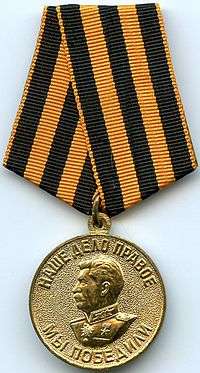Moscow Victory Day Parade
The Moscow Victory Day Parade (Russian: Парад Победы в Москве, tr. Parad Pobedy v Moskve) refers to the annual military parade of the Russian Armed Forces on Moscow's Red Square every 9 May during the Victory Day celebrations. The most important parade of those being held on May 9 is the one held on Moscow's Red Square, with the President of Russia as the guest of honor and keynote speaker in virtue of his constitutional mandate as Supreme Commander of the Russian Armed Forces.
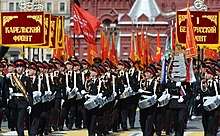
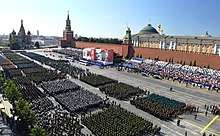
According to anthropologist Sergey Ushakin, modern victory parades are intended to demonstrate the direct and immediate connection of the present with the past and to materialize the connection between generations.[1] Long time parade commander Oleg Salyukov described them as a "celebration for people, not show of militarism" referring to accusations of the parade being used as show of Russian military might.[2]
History
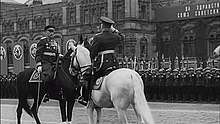
The first military parade on Red Square in honor of the defeat of Nazi Germany took place with the participation of the Soviet Armed Forces and a guest appearance by a small detachment from the First Polish Army on 24 June 1945. It was the longest and largest parade in the Soviet capital, lasting hours and utilizing 40,000 Red Army soldiers as well as 1,850 military vehicles. It took place over a month after the victory actually took place on 9 May, the day of Germany's surrender. Intensive preparations for the parade took place in late May and early June in Moscow. The preliminary rehearsal of the Victory Parade took place at Khodynka Aerodrome, and the general rehearsal on Red Square on June 22. The day after the parade, a reception was held in the Grand Kremlin Palace in honor of the participants in the Victory Parade.[3] After the 1945 parade, Victory Day became obsolete in the Soviet Union, with parades only being held on major jubilee, in part to make favor for the October Revolution Day parade which took place every year in the winter. In the decades that followed, 3 parades were held: in 1965, 1985,[4][5] and 1990.[6][7][8][9]
Parades were not held between 1991-1994, partly because First Deputy Prime Minister Gennady Burbulis thought of it as impractical primarily based on the state of the country at that time, particularly in terms of costs and expenses.[10] The Victory Day Parade of 1995 was held to commemorate the golden jubilee of the Soviet victory in the war.[11] It was the first one held in the newly formed Russian Federation, taking place 5 years after the fall of the Soviet Union. The parade was divided into two parts, a full military parade on Poklonnaya Hill and a veterans ceremony on Red Square. The 2020 edition of the parade, marking the 75th anniversary of the victory over Nazi Germany, was postponed due to the coronavirus pandemic.[12][13] It was the first time since the collapse of the Soviet Union and the resumption of military parades in 1995 that parade was to be cancelled on a holiday itself.
Description
On the morning of the parade, an estimated 14,000 military personnel, including a regiment of female cadets and youth cadets, assemble by battalions on the square together with the more than 210 vehicles and 3,800 vehicle crews assembled on Tverskaya Street just north of the Manezhnaya Square, Moscow, during the major parades a battalion or company of historical Red Army vehicles, estimated at around 36 vehicles and composed of just the T-34, GAZ-67 and the SU-100 plus the optional BM-13N (or at around an estimated 480 when counting other vehicles of the war which would take part just like in the parades of 1985 and 1990) assemble on the street as well with modern military hardware of the Armed Forces and the National Guard (and optionally by the other uniformed organizations). At the air bases outside Moscow (in areas like Kubinka), more than 88 aircraft are assembled with their aircrews for the flypast segment.
The celebrations begin at 9:55 am Moscow Standard Time with the arrival of the President and the Prime Minister of Russia to a special grandstand in front of Lenin's Mausoleum, where six of the past parades were reviewed by national leaders. They greet the Chief of the General Staff of the Armed Forces, service commanders, deputy ministers in the Ministry of Defence and commanders of the support units within the Armed Forces, together with veterans, veterans' families and representatives of the Suvorov and Nakhimov Schools assembled. To the left and right of the grandstand are the stands wherein veterans, veterans' families and descendants and families of personnel killed in action are gathered. In between the grandstand to the south of the stands are two platoons of armed linemen and markers from the 154th Preobrazhensky Independent Commandant's Regiment in the Imperial-styled military uniforms and some unarmed half-companies of the Kremlin Regiment, both of which would be later taking post to mark the distance of the troops marching past and to line the square's western side facing the Kremlin together with extra drum majors from the Band Service, which are there to coordinate the march past to be timed in with the music of the bands since the parade of 1995. At the square, the parade commander (usually a Colonel General or rarely a General of the Army with the billet of Commander of the Ground Forces or as the Deputy Chief of General Staff) takes his place in a special an Aurus Senat armored limousine (formerly a Zil until 2018), having just received the report on the readiness of the parade from the commandant of the Combined Arms Academy who is a general officer.
In the seconds prior to the parade, the announcer traditionally says the following: "Attention, this is Moscow speaking and showing. Listen to and watch Red Square. This is the Victory Parade in honor of the (insert anniversary year) anniversary of the Victory in the Great Patriotic War of 1941-1945!".[14] As the Spasskaya Tower of the Kremlin sounds the chimes at 10 am the parade commander orders the parade to present arms as the 154th PICR's 1st Honor Guard Company Colour Guard, to the melody of The Sacred War being played by the Massed Bands, marches into the square and past the dignitaries with guard carrying both the Flag of Russia and the Victory Banner. As the colour guards approach the grandstand, the colour officers execute eyes left and resume above face after passing by. This is followed by the parade being commanded to stand at ease after the colours take their place at the northwest end of the square fronting the State Historical Museum, besides the colour of the Armed Forces. Then the Minister of Defence (usually a billet of a General of the Army) is driven on the limousine to the center of the square nearest the tribune, the parade presenting arms again at this point. The parade commander informs him of the readiness of the parade to be inspected. The report is received, and to the tune of the Massed Bands the Minister and the parade commander are driven to inspect the parading contingents each together with the bands. As the limousines stop the Minister sends Victory Day greetings to each of the parading contingents, in which they respond with a threefold loud Oorah that is heard all over the grounds. After the final greeting, the Massed Bands strike up to Slavsya from A Life for the Tsar as the PC returns to his place, the Minister driven to the grandstand amidst louds shouts of Oorah by the parade contingents where he dismounts the limousine and the Corps of Drums of the Moscow Military Music College, an affiliate of the Suvorov Military Schools, take their place behind the parade commander's car led by the Commandant of the College and the college colour guard. The parade is ordered to stand at ease after the Minister informs the President that the parade is formed up for the march past in review and its inspection officially completed. In the 1965, 1985 and 1990 parades, the limousines would inspect the personnel of the mobile column at the Manezhnaya Square formed into battalions, in remembrance of the mounted inspection of the original 1945 parade, which included cavalry, tachankas and horse artillery in addition to the huge mobile column. Following the report of the Minister of Defence, the keynote holiday address to the nation of the President follows, preceded by a fanfare by the Massed Bands, usually Govovin's Moscow Fanfare. A moment of silence, since 2014, features as part of the keynote address.
As the president finishes the address and a threefold Oorah resounds all over the square by the entire parade assembled and the honor guard presents arms, the Massed Bands play the National Anthem of Russia and a ceremonial battery armed with the 76 mm divisional gun M1942 (ZiS-3) fire a 21-gun salute. As the anthem ends, the bands sound Retreat as the honor guard executes order arms and the parade commander orders the parade to commence the march past in the following manner:
- Parade... attention! Ceremonial march past!
Form battalions! Distance by a single lineman! First battalion will remain in the right, remainder... left.. turn!
Slope.. arms!
- Parade... attention! Ceremonial march past!
As the command is given to start the linemen take their places and the field markers also as well at the south end of the square. As the PC ends the commands with Eyes to the right, forward, quick march! the Corps of Drums of the Moscow Military Music College, as is their tradition since 1938, march first to the tune of the "General Miloradovich" by one of its late alumni, Lieutenant General Valery Khalilov, one of the longest serving Senior Directors of Music of the Military Band Service and conductor of the Moscow area massed bands from 2002 to 2016, being played by the drummers and fifers. As the massed bands start playing the Corps of Drums stop playing by the signal of the Corps Drum Major and swings its drumsticks while on the eyes right. The Corps is followed by the colour guard of the 154th PICR and its 1st Honor Guard Company, during jubilee parades, the colour guard is followed by a company of colour bearers carrying the front standards in the order of their marchpast in the 1945 Victory Parade and their escorts, colours from the regiments, brigades and divisions which took part in the original 1945 parade and a historical unit of servicemen in period uniforms, optionally joined by the Kuban Cossacks, in memory of their contingent which marched past on that very parade, and the Escort Cavalry Squadron of the Kremlin Regiment plus a number of international contingents. This is followed by the rest of the parade ground column, starting with the youth contingents and by the Combined Arms Academy, among other troops.
The ground column ends, as the massed bands play either Victory Day or "Let's Go", with the traditional marchpast of the Moscow Higher Military Command School, which has been done since the golden jubilee October Revolution Day parade of 1967 as a commemoration of the school's importance as the first military officer cadet school to be established in modern-day Russia, the first time it had been seen last in the Victory Day parade ground column was in 1985 (the two battalions of the school's Corps of Cadets also march past the square in memory of the cadets who fought in the 1941 Battle of Moscow). With the ground segment competed the bands stop playing at the signal of the senior director and the senior drum majors and, to give way to the mobile column, march towards the facade of the GUM department store, with two sections of the MMMC Corps of Drums at either side of the bands, reflecting the formations of the massed bands alongside the Corps of Drums in the Red Square parades of the 1950s and the 1960s.
The mobile column starts with the drivepast of historical vehicles in jubilee years. In non-special anniversary years only a T-34/85 medium battle tank carrying the Victory Banner leads the column of tens of military vehicles and equipment. As the Massed Bands play appropriate music the column drives past the stands in the Square, with the crew commanders and unit leaders executing a hand salute in the eyes right position (save for MRLs and mobile ICBMs). Following the end of the mobile column with the service flags of the three branches of the Armed Forces the flypast then follows, usually as the Bands play the Aviamarch and other air marches the flypast marks the formal termination of the parade with tens of aircraft from the Air Force flying past above the square in full view of everyone in attendance.
Full order of the parade
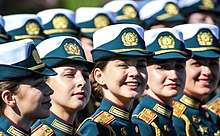
The parade march past order, since the parade of 2010, is arranged in the following manner as it passes before the dignitaries:
- Corps of Drums, Moscow Military Music College
- 154th Preobrazhensky Independent Commandant's Regiment
- Youth contingents
- Survorov and Nakhimov Military Schools
- Cadet Corps colleges of the Armed Forces and other uniformed organizations
- Young Army Cadets National Movement Moscow Area (led by the Chairman, includes female students of the Moscow National Pensions School Cadet Corps)
- Russian Ground Forces
- Russian Aerospace Forces
- Russian Navy
- Regiment of female cadets of Armed Forces academies (starting 2016 as a battalion, expanded to full regiment in 2017)
- Strategic Missile Forces
- Russian Airborne Forces
- Military Police
- NBC Protection Military Academy
- Russian Railway Troops
- Border Service of the Federal Security Service
- Ministry of Emergency Situations
- Police of Russia
- National Guard of Russia Separate Operational Purpose Division (National Guard Forces Command)
- Military forces of the 1st Guards Tank Army, Western Military District
- Moscow Higher Military Command School Supreme Soviet of Russia
Preparations
.jpg)
Early preparations for the parade begin in the last two months of the previous year. In these early stages, organizers at the MoD discuss the size of the parade, units/military equipment attending, extra details and on jubilee years, the invitation pf foreign troops. During this time, regular participants practice their drill routines from their home units at various locations. Full parade rehearsals begin in March at a training center in the village of Alabino, which is located in the Moscow Oblast. In their working uniforms, parade participants do a full run through of the entire ceremony to the closest extent possible. In the last week of April, the rehesals are moved to Red Square, as they are conducted in the evening time. The flypast segment of the parade begin during these practice runs with all aircraft practicing from the Kubinka airfield. In some cases, the flypast is rehearsed solely without any mobile and ground columns. Typically, the final dress rehearsal takes place 2–3 days before the actual parade and is usually livestreamed on outlets such as Ruptly.
Presiding officers
| Year | Parade commander | Parade inspector |
|---|---|---|
| 1945 | Marshal Konstantin Rokossovsky | Marshal Georgy Zhukov |
| 1965 | General of the Army Afanasy Beloborodov | Marshal Rodion Malinovsky |
| 1985 | General of the Army Pyotr Lushev | Marshal Sergey Sokolov |
| 1990 | Colonel General Nikolai Vasilyevich Kalinin | Marshal Dmitry Yazov |
| 1995 | General of the Army Vladimir Govorov/Colonel General Leonid Kuznetsov | Marshal Viktor Kulikov/General of the Army Pavel Grachev |
| 1996 | Colonel General Leonid Kuznetsov | General of the Army Pavel Grachev |
| 1997 | Lieutenant General Igor Puzanov | Colonel General Leonid Kuznetsov |
| 1998 | Colonel General Leonid Kuznetsov | Marshal Igor Sergeyev |
| 1999 | Colonel General Igor Puzanov | Marshal Igor Sergeyev |
| 2000 | General of the Army Vladimir Govorov/Colonel General Igor Puzanov | Marshal Igor Sergeyev |
| 2001 | Colonel General Nikolai Makarov | Sergei Ivanov |
| 2002 | Colonel General Ivan Yefremov | Sergei Ivanov |
| 2003 | Colonel General Ivan Yefremov | Sergei Ivanov |
| 2004 | General of the Army Ivan Yefremov | Sergei Ivanov |
| 2005 | General of the Army Ivan Yefremov | Sergei Ivanov |
| 2006 | Colonel General Vladimir Bakin | Sergei Ivanov |
| 2007 | General of the Army Vladimir Bakin | Anatoliy Serdyukov |
| 2008 | General of the Army Vladimir Bakin | Anatoliy Serdyukov |
| 2009 | Colonel General Valery Gerasimov | Anatoliy Serdyukov |
| 2010 | Colonel General Valery Gerasimov | Anatoliy Serdyukov |
| 2011 | Colonel General Valery Gerasimov | Anatoliy Serdyukov |
| 2012 | Colonel General Valery Gerasimov | Anatoliy Serdyukov |
| 2013 | Colonel General Vladimir Chirkin | General of the Army Sergey Shoygu |
| 2014 | Colonel General Oleg Salyukov | General of the Army Sergey Shoygu |
| 2015 | Colonel General Oleg Salyukov | General of the Army Sergey Shoygu |
| 2016 | Colonel General Oleg Salyukov | General of the Army Sergey Shoygu |
| 2017 | Colonel General Oleg Salyukov | General of the Army Sergey Shoygu |
| 2018 | Colonel General Oleg Salyukov | General of the Army Sergey Shoygu |
| 2019 | General of the Army Oleg Salyukov | General of the Army Sergey Shoygu |
| 2020 | General of the Army Oleg Salyukov | General of the Army Sergey Shoygu |
Traditions and recent additions

2008 marked a return to tradition as well as the reorganization of the parade to fit the modern era. For the first time, a mobile column appeared at a Victory Day Parade in the Russian Federation appeared, a return to a tradition that was last seen in 1991, and abandoned in 1995. It was abandoned due to reconstruction of the Iberian Gate and Chapel, which was originally destroyed to fill the very purpose of making way for tanks during the mobile column of the parade. That same year an airshow was introduced and it also became the first major Russian military parade to be seen on worldwide television when RT carried a live broadcast of the parade for the first time. In 2018, an exhibition drill performance by the 1st Honor Guard Company, 154th Preobrazhensky Independent Commandant's Regiment took part in the segment of the parade together with a drumline from the Moscow Military Music College the first time since 2007 in a return to a tradition that began in the 2001 parade. It was reinstated in honor of the centennial anniversary of the 1918 foundation of the Red Army.[15]
Each of the contingents, since 1996, have carried the historical military colors of the 1942 (Red Army, Soviet Air Force, People's Militia) and 1932/1944 (Soviet Navy) patterns at the head of their formations, honoring the millions of who served in the ranks of the military and law enforcement services of the former Soviet Union during the Second World War. Since the 60th anniversary parade, a wreath laying ceremony is held immediately after the parade at the Tomb of the Unknown Soldier, with a mini parade of the uniformed services and an honour guard also taking place.
MC
Since 2007, an MC's voice has been heard on Red Square during the parade.[16] The idea was concieved by President Putin in 2005, after having been to a dress rehearsal in which people were not given the names of military units on parade, a privlege afforded to honored guests who were given a pamphlet. After experimenting with live commentary, it was decided two years later that recorded audio would be used to announce the parade in order to keep with the march step of the formations in the grounds of the square, and it has been a part of the parade ever since. In all those years, the voice has been of People's Artist of Russia Yevgeny Khoroshevtsev, a graduate of the Russian Institute of Theatre Arts as well as the announcer of protocol events of the President of the Russian Federation. The MC's booth is located in the stands, at the very top.[17]
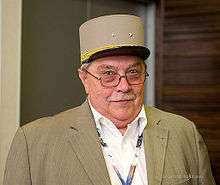
Aside from the parade, he also together with Anna Shatilova, is the MC for the memorial parade in honor of the 1941 October Revolution Parade as well as the Spasskaya Tower Military Music Festival and Tattoo.[18][19][20]
Historical column
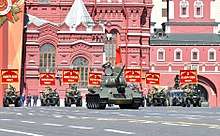
Particularly on jubilee years, a historical column of troops takes part in the parade. It is designed to portray troops and their uniforms dating back to the war era. In 2005, the historical column wore replica uniforms similar to those worn in the 1945 Victory Parade.
Order of marchpast of historical column in major jubilee parades (order as of 2005, 2015 and 2020)
- Infantry of the Red Army
- Tank forces
- Artillery
- Engineering formations
- Reconissance and commando formations
- K-9 units of NKVD
- Soviet Air Force
- Soviet Navy
- Partisans in combat uniforms
- Border guardsmen
- Personnel of the Militia
- Kuban and Don Cossacks
- Servicemen who took part in the Victory Parade of 1945
- 1st Cavalry Squadron, Presidential Cavalry Escort Battalion, Kremlin Regiment
Massed Bands
Around 1,100 bandsmen of the massed bands under the direction of the Senior Director of Music of the Military Band Service of the Armed Forces of Russia (an appointment bestowed to either a colonel or a general rank officer), are a central part of the parade. At least 15 bands are usually available for the march pasts.[21] The massed military Bands in attendance are normally composed of:[22]
- Headquarters Band of the Moscow Military District
- Central Military Band of the Ministry of Defense of Russia
- Headquarters Band, of the National Guard of Russia
- Band of the Dzerzhinsky Division[23]
- Central Navy Band of Russia
- Band of the Moscow Military Conservatoire, Military University of the Ministry of Defense of the Russian Federation
- HQ Band of the Ministry of Emergency Situations
- Band of the Combined Arms Academy of the Armed Forces of the Russian Federation
- Band of the Military Technological University
- Band of the Peter the Great Military Academy of the Rocket Forces of Strategic Importance
- Band of the 5th Tamanskaya Guards Ind. Motor Rifle Brigade "Mikhail Kalinin"
- Band of the 4th Kantemir Guards Armored Brigade "Yuri Andropov"
- Band of the 25th Sevastopol Guards Motor Rifle Brigade
- Band of the Gagarin-Zhukovsky Combined Air Force Academy
- Headquarters Band of the Russian Airborne Troops
- Band of the 147th of the Automobile Base of the Ministry of Defense[24]
Musical pieces used
- Slavsya (Славься)
- Long Live our State (Да здравствует наша держава)
- General Miloradovich March (Марш Генерал Милорадович)
- Capital March (Столичный Марш)
- Triumph of Winners (Триумф победителей)
- Aviator's March (Авиамарш)
- Let's Go (В путь!)
- Song of the Soviet Army (Песня о Советской Армии)
- Farewell of Slavianka (Прощание славянки)
- Moscow Parade Fanfare (Московская парадная фанфара)
- Signal "End" (Сигнал «Отбой!»)
- Slow March of the Officer Schools (Встречный марш военных училищ)
- Preobrazhensky Regiment March (Марш Лейб-гвардии Преображенского полка)
- The Sacred War (Священная война)
- "Hero" March (Марш «Герой»)
- Serving Russia (Служить России)
- Den Pobedy (День Победы)
- March of the Artillerymen (Марш артиллеристов)
- March of the Defenders of Moscow (Марш защи́тников Москвы́)
- Katyusha (Катюша)
- We Need Only One Victory (Our 10th Parachute Battalion) (Нам нужна одна победа (10-й наш десантный батальон))
Foreign presence
Guests
- 1995 – See 1995 Moscow Victory Day Parades
- 2005 – See 2005 Moscow Victory Day Parades
- 2010 – See 2010 Moscow Victory Day Parade
- 2015 – See 2015 Moscow Victory Day Parades
- 2016 – President of Kazakhstan Nursultan Nazarbayev
- 2017 – Moldovan President Igor Dodon
- 2018 – Israeli Prime Minister Benjamin Netanyahu and Serbian President Aleksandar Vučić[25][26][27]
- 2019 – Elbasy and Chairman of the Security Council of Kazakhstan Nursultan Nazarbayev[28]
- 2020 – See 2020 Moscow Victory Day Parade
Foreign troops

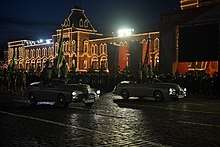
At the first parade in 1945, the color squad of the First Polish Army was the only foreign contingent invited to the ceremony. In 1985, veterans of the Polish People's Army (Polish 1st Infantry Division) and the Czechoslovak People's Army (Czechoslovak 1st Corps) took part in the veterans procession of the parade.[29] In 2010, President Dmitry Medvedev invited foreign troops to the parade for the first time since the fall of the USSR, and included military units countries allied with the Soviet Union during World War II. Representation at the parade included contingents from France, Poland, the United Kingdom, the United States and other members of the Commonwealth of Independent States. Upon request from the Ministry of Defense of Turkmenistan, the Turkmen contingent was led by an officer on horseback, with the horse being flown into Moscow from Ashgabat.[30] After a 5-year break, the platinum jubilee parade in 2015 saw the return of units from the CIS (save for Moldova and Ukraine) and saw parade participants from the Serbian Guards Unit[31] the Beijing Capital Garrison Honor Guard Battalion,[32] Mongolian State Honor Guard, and The Grenadiers.[33] representing their countries for the first time. The 2020 parade saw the return of all participants of the 2015 parade (with most of the post-Soviet nations being represented by different units) as well as the return of Turkmenistan and Moldova, whose militaries returned after 10 years. Turkmen contingent for the 2020 parade consisted of two color guards (one carrying the Flag of Turkmenistan and the other carrying the combat flag of the 748th Infantry Regiment) riding in two GAZ-M20 Pobeda cars brought in from the Turkmen capital.[34]
List of parades
- Moscow Victory Parade of 1945
- 1965 Moscow Victory Day Parade
- 1985 Moscow Victory Day Parade
- 1990 Moscow Victory Day Parade
- 1995 Moscow Victory Day Parade
- 1996 Moscow Victory Day Parade
- 1997 Moscow Victory Day Parade
- 1998 Moscow Victory Day Parade
- 1999 Moscow Victory Day Parade
- 2000 Moscow Victory Day Parade
- 2001 Moscow Victory Day Parade
- 2002 Moscow Victory Day Parade
- 2003 Moscow Victory Day Parade
- 2004 Moscow Victory Day Parade
- 2005 Moscow Victory Day Parade
- 2006 Moscow Victory Day Parade
- 2007 Moscow Victory Day Parade
- 2008 Moscow Victory Day Parade
- 2009 Moscow Victory Day Parade
- 2010 Moscow Victory Day Parade
- 2011 Moscow Victory Day Parade
- 2012 Moscow Victory Day Parade
- 2013 Moscow Victory Day Parade
- 2014 Moscow Victory Day Parade
- 2015 Moscow Victory Day Parade
- 2016 Moscow Victory Day Parade
- 2017 Moscow Victory Day Parade
- 2018 Moscow Victory Day Parade
- 2019 Moscow Victory Day Parade
- 2020 Moscow Victory Day Parade
See also
- Victory Day (9 May)
- Victory Parade
- Victory Day Parades
External links
- Official website of the 2019 Moscow parade
- Official website of the 2020 Moscow air show
- 360° panoramas of the parade in QuickTime VR technology
Photos and Videos
References
- Сергей Ушакин. Вспоминая на публике: об аффективном менеджменте истории. Память, выпавшая из времени: российские официальные конструкции памяти // Гефтер.ру, 14.11.2014
- https://tass.com/society/1170491/amp
- https://www.prlib.ru/history/619337
- http://vvpobeda.shpl.ru/pob1985.html
- "Как проходили парады Победы в 1945–2016 годах". www.dp.ru. Retrieved 2019-02-04.
- "День Победы: история военных парадов". ТАСС. Retrieved 2019-02-04.
- Военные парады на Красной площади / Под ред. В. М. Архипова, И. П. Репина. 3-е изд. М., 1987.
- https://m.sputnik-georgia.ru/russia/20200417/248265859/Istoriya-paradov-Pobedy-na-Krasnoy-ploschadi.html?mobile_return=no
- "Парад с перебоями". www.kommersant.ru (in Russian). 2011-05-16. Retrieved 2020-06-26.
- http://tass.ru/obschestvo/1171423
- https://tass.ru/obschestvo/8263303
- https://www.themoscowtimes.com/2020/04/16/putin-postpones-75th-victory-day-parade-over-coronavirus-a70022
- https://tass.com/society/1171175/amp
- "В параде Победы в Москве впервые поучаствуют "Терминаторы"".
- https://www.1tv.ru/shows/dobroe-utro/pro-pobedu/golos-voennogo-parada
- https://www.mk.ru/amp/social/2016/05/05/golos-parada-pobedy-moya-budochka-naverkhu-tribun.html
- Голос Победы: секреты легендарного диктора Евгения Хорошевцева, 09.05.2016 г. Межгосударственная телерадиокомпания «Мир».
- Голос парада Победы: «Моя будочка наверху трибун», 05.05.2016 г. Светлана Самоделова. Электронное периодическое издание «MK.ru».
- Интервью с Евгением Хорошевцевым (видео с 8 мин 40 сек по 11 мин 5 сек), 05.05.2017 г. Видеозапись программы «Служу России» телеканала «Звезда».
- https://novayagazeta.ru/articles/2020/05/21/85466-parad-vyhodit-na-plato
- https://spasstower.livejournal.com/35537.html
- https://www.rosgvard.ru/ru/news/article/svodnyj-voennyj-orkestr-rosgvardii-provel-pervuyu-sovmestnuyu-repeticiyu-ko-dnyu-pobedy
- http://mil.ru/147ab/subunits/orchestra.htm
- "Israel's Netanyahu To Attend Victory Day Parade, Meet Putin". RadioFreeEurope/RadioLiberty.
- "Prime Minister of Israel Benjamin Netanyahu will visit Moscow on May 9".
- "Meeting with President of Serbia Aleksandar Vucic".
- Matthew Luxmoore. "Russia Marks WWII Victory Day With Military Parades, Commemorative Marches". www.rferl.org. Archived from the original on 10 May 2019. Retrieved 10 May 2019.
- "The Moscow parade began with a 20-minute march of troops from Poland and Czechoslovakia as well as the Soviet veterans and present units".
- "Victory parade – a move to the future". Voice of Russia. 28 April 2010. Archived from the original on 29 April 2010. Retrieved 4 May 2010.
- Sputnik (6 April 2015). "Serbian Army to Take Part in Victory Day Parade in Moscow". Archived from the original on 4 June 2015. Retrieved 10 May 2015.
- Chinese PLA Honor Guards to Participate in Russia's Victory Day Parade: Defense Ministry. YouTube. 1 May 2015. Archived from the original on 7 December 2015. Retrieved 10 May 2015.
- "Indian Army Grenadiers Regiment to take part in 2015 Victory Day Parade in Moscow's Red Square". India Today. 15 April 2015. Archived from the original on 16 April 2015. Retrieved 16 April 2015.
- https://turkmenportal.com/blog/28376/turkmenskie-voennye-prinyali-uchastie-v-parade-pobedy-na-krasnoi-ploshchadi
